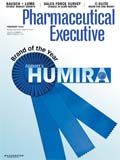Brand Success: It's Not Serendipity
A new generation of products for inflammatory disease is coming forward, promising better promise and possibly a cure.
MID-WINTER IS A TIME WELL SUITED FOR AWARDS—an act of community recognition that softens the chill and casts extra light against the early dark of the day. February is thus the month where Pharm Exec consults widely to recognize and reward a single medicine that exemplifies industry innovation in its widest frame. We approach innovation as a beacon for all seasons—not just a product, representing a measurable clinical advance in the standard of treatment, but a process as well, where all that good science is accessorized with creative marketing to establish awareness beyond the regulator and build uptake among clinicians and patients to achieve a dominant position in its therapeutic class.

William Looney
This year's winner is the Abbott blockbuster monoclonal antibody Humira (adalimumab), an injectable anti-TNF treatment for inflammatory conditions such as rheumatoid arthritis, Crohn's disease, and psoriasis. Confirming the argument that success has many fathers, Humira's trajectory began as a coded compound ceded to Abbott through its purchase of the BASF/Knoll pharmaceutical business in December 2000. The drug has proven to be a true diamond in the rough, with sales of more than $8 billion alone last year, a number that far exceeds the $6.9 billion that Abbott spent acquiring BASF's entire pharmaceutical portfolio. In fact, Humira is in line to succeed Lipitor atop the list of worldwide sales of patented medicines, a remarkable performance for a biologic drug with a well defined but limited audience of patients.
What is most instructive about Humira is its staying power. The drug has enjoyed a consistent record of "best in class" sales leadership despite facing competition that is arguably more intense than in other therapies. The anti-inflammatory space is very crowded, with Humira competing for share against two other heavily promoted alternative brands from Amgen/Pfizer and J&J. Cost of therapy in this segment is high. There has been strong payer resistance to designating these monoclonal antibodies as first-line treatment.
How a rapidly maturing medicine like Humira continues to post double-digit growth is no mystery. Reading between the lines in Ben Comer's feature report, there are three lessons to draw from Humira's success. First is the commitment Abbott made to ensuring Humira had superior evidence to make the case for clinical differentiation and value-based reimbursement. The company has invested millions in producing long-range efficacy studies demonstrating how Humira reduces inflammation, stops disease progression, and yields broader health system savings through improved quality of life.
Second, Abbott has focused on extending the drug's franchise into new indications, with the result that Humira stands out against the competition in obtaining FDA approval for use in each of the three major inflammatory disease segments: joint, gastroenterology, and dermatology. Pursuit of new indications followed a logical, sequential pattern of accumulating evidence that built on the company's research prioritization of inflammatory disease as an evolving field with great scientific promise. Again, the company earmarked significant resources to making the clinical case for the expanded labels, working closely with regulators to identify in advance what evidence was needed to drive a positive decision. The approach illustrates the importance of anticipatory "lifecycle" planning in wresting top value from a drug: It's not just erecting a strong marketing defense for the individual brand, but leveraging the company's full portfolio of assets behind other ways to build share—including partnerships with payers and even a competitor.
Finally, Abbott took great pains to engage the patient community, taking every opportunity to translate health economics, clinical benefit, and safety issues into simple messaging that focused on inflammatory disease as a disability—manifested differently in each individual—that can be successfully managed. Quality of life ranks at the top of concerns for individuals with these conditions, and Abbott's marketing made a point of referencing how Humira, while providing no cure, can allow for a resumption of normal activities.
While Pharm Exec chooses only one medicine as its "Brand of the Year," we take pride in acknowledging that the fruits of success are widely dispersed. One of the attributes of innovation is that not only patients, but industry and society as well, can share in Humira's longevity as a therapeutic breakthrough. Thanks to Humira and its sister biologic products, inflammatory disease is now one of the most prolific segments for new drug research. A new generation of treatments is coming forward, promising better performance—and possibly a cure. A warming thought for the mid-winter blues.
William
LooneyEditor-in-Chief

FDA Grants Priority Review to Regeneron’s Eylea for Macular Edema Following Retinal Vein Occlusion
April 18th 2025Regulatory action was based on data from the Phase III QUASAR trial, which demonstrated that Eylea HD dosed every eight weeks achieved non-inferior visual acuity outcomes compared to Eylea in patients with macular edema following retinal vein occlusion.
Addressing Disparities in Psoriasis Trials: Takeda's Strategies for Inclusivity in Clinical Research
April 14th 2025LaShell Robinson, Head of Global Feasibility and Trial Equity at Takeda, speaks about the company's strategies to engage patients in underrepresented populations in its phase III psoriasis trials.
New Insights Into T Cell Exhaustion and Inflammation in Long COVID
April 17th 2025Nigel McCracken, chief operating officer, Virax Biolabs, discusses new findings that reveal altered cytokine activity and evidence of T cell exhaustion in long COVID patients, providing deeper insight into post-infection immune disruption.
Key Findings of the NIAGARA and HIMALAYA Trials
November 8th 2024In this episode of the Pharmaceutical Executive podcast, Shubh Goel, head of immuno-oncology, gastrointestinal tumors, US oncology business unit, AstraZeneca, discusses the findings of the NIAGARA trial in bladder cancer and the significance of the five-year overall survival data from the HIMALAYA trial, particularly the long-term efficacy of the STRIDE regimen for unresectable liver cancer.
Amgen’s Imdelltra Demonstrates Significant Overall Survival Improvement in Small Cell Lung Cancer
April 16th 2025In the Phase III DeLLphi-304 trial, patients with small cell lung cancer administered Imdelltra achieved a statistically significant and clinically meaningful improvement in overall survival compared to standard-of-care chemotherapy.